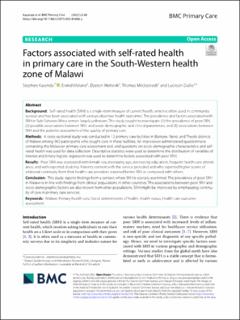| dc.contributor.author | Kasenda, Stephen | |
| dc.contributor.author | Meland, Eivind | |
| dc.contributor.author | Hetlevik, Øystein | |
| dc.contributor.author | Mildestvedt, Thomas | |
| dc.contributor.author | Dullie, Luckson Wandani | |
| dc.date.accessioned | 2022-12-29T08:57:27Z | |
| dc.date.available | 2022-12-29T08:57:27Z | |
| dc.date.created | 2022-05-20T08:45:03Z | |
| dc.date.issued | 2022 | |
| dc.identifier.issn | 2731-4553 | |
| dc.identifier.uri | https://hdl.handle.net/11250/3039683 | |
| dc.description.abstract | Background
Self-rated health (SRH) is a single-item measure of current health, which is often used in community surveys and has been associated with various objective health outcomes. The prevalence and factors associated with SRH in Sub-Saharan Africa remain largely unknown. This study sought to investigate: (1) the prevalence of poor SRH, (2) possible associations between SRH, and socio-demographic and clinical parameters, and (3) associations between SRH and the patients’ assessment of the quality of primary care.
Methods
A cross-sectional study was conducted in 12 primary care facilities in Blantyre, Neno, and Thyolo districts of Malawi among 962 participants who sought care in these facilities. An interviewer-administered questionnaire containing the Malawian primary care assessment tool, and questions on socio-demographic characteristics and self-rated health was used for data collection. Descriptive statistics were used to determine the distribution of variables of interest and binary logistic regression was used to determine factors associated with poor SRH.
Results
Poor SRH was associated with female sex, increasing age, decreasing education, frequent health care attendance, and with reported disability. Patients content with the service provided and who reported higher scores of relational continuity from their health care providers reported better SRH as compared with others.
Conclusion
This study reports findings from a context where SRH is scarcely examined. The prevalence of poor SRH in Malawi is in line with findings from clinical populations in other countries. The associations between poor SRH and socio-demographic factors are also known from other populations. SRH might be improved by emphasizing continuity of care in primary care services. | en_US |
| dc.language.iso | eng | en_US |
| dc.publisher | BMC | en_US |
| dc.rights | Navngivelse 4.0 Internasjonal | * |
| dc.rights.uri | http://creativecommons.org/licenses/by/4.0/deed.no | * |
| dc.title | Factors associated with self-rated health in primary care in the South-Western health zone of Malawi | en_US |
| dc.type | Journal article | en_US |
| dc.type | Peer reviewed | en_US |
| dc.description.version | publishedVersion | en_US |
| dc.rights.holder | Copyright 2022 The Author(s) | en_US |
| dc.source.articlenumber | 88 | en_US |
| cristin.ispublished | true | |
| cristin.fulltext | original | |
| cristin.qualitycode | 1 | |
| dc.identifier.doi | 10.1186/s12875-022-01686-y | |
| dc.identifier.cristin | 2025837 | |
| dc.source.journal | BMC Primary Care | en_US |
| dc.identifier.citation | BMC Primary Care. 2022, 23, 88. | en_US |
| dc.source.volume | 23 | en_US |

